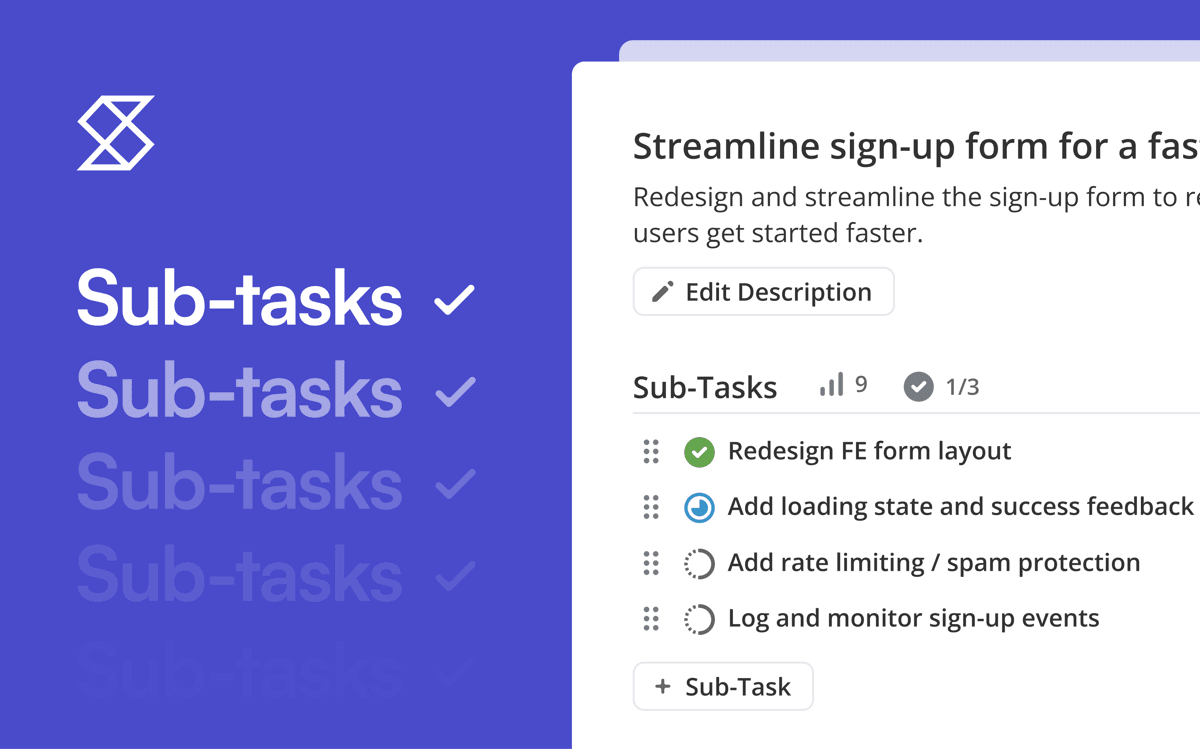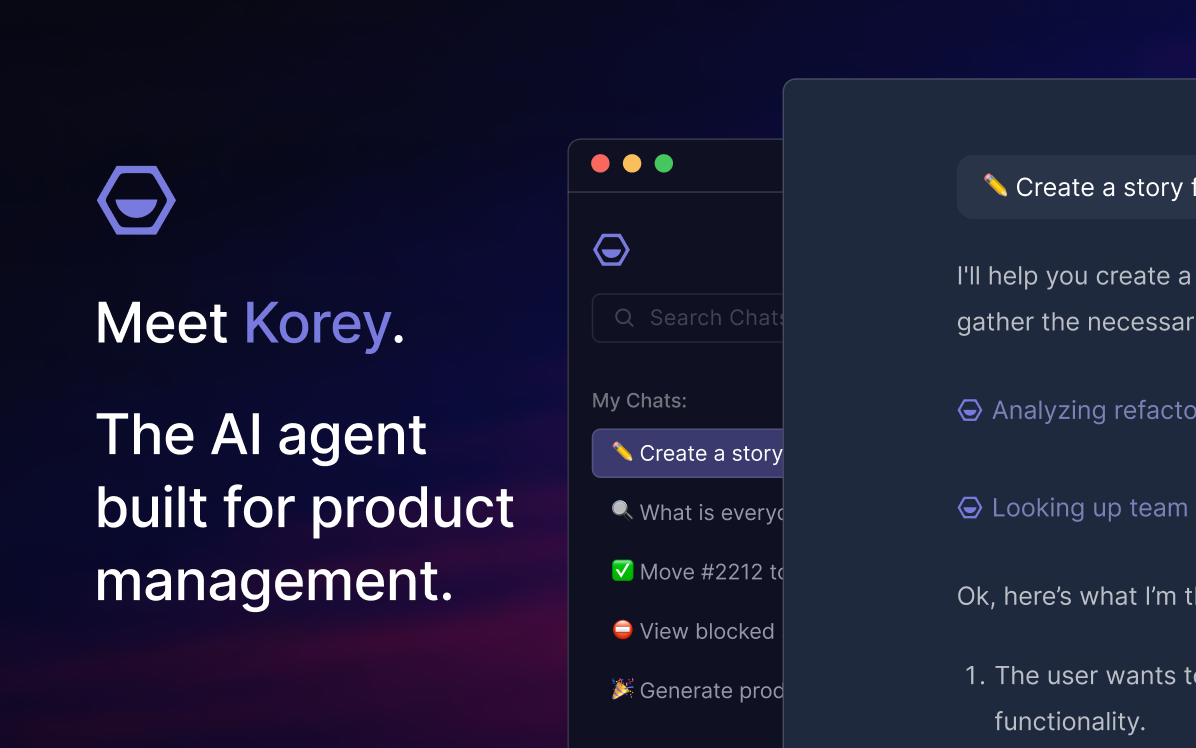Objectives are the backbone of execution. They're how you translate strategy into action, align your team around what matters, and measure whether you actually moved the needle. Yet many product and engineering managers struggle to write them well.
The difference between a vague objective and a sharp one? It's the difference between a team that drifts and a team that ships. Let's break down what makes an objective actually work.
What Are the Core Elements of a Good Objective?
A good objective does three things:
It's outcome-focused, not activity-focused. "Launch a new dashboard" is an activity. "Reduce time-to-insight for users by 40%" is an outcome. Activities are what you do; outcomes are what changes because you did it. Your team should know why they're building, not just what they're building.
It's measurable. You need to know if you hit it or missed it. Vague language like "improve performance" or "better user experience" sounds good in a meeting, but it won't tell you if you succeeded. Measurable means you can point to a number, a metric, or a clear signal that proves you got there.
It's aligned with business strategy. An objective that doesn't connect to what the company is trying to achieve is just noise. Whether you're trying to reduce churn, increase revenue, improve retention, or expand into a new market, your objectives should ladder up to those bigger goals. Your team needs to understand how their work matters to the business.
Is the SMART Framework Still Relevant for Modern Teams?
You've probably heard of SMART goals. They're not trendy anymore, but they work because they force clarity:
- Specific: What exactly are you trying to achieve? "Reduce API response time" is more specific than "improve performance."
- Measurable: How will you know you succeeded? "Reduce API response time from 500ms to 200ms" gives you a target.
- Achievable: Can your team realistically hit this in the timeframe you've set? Stretch goals are good; impossible goals kill morale.
- Relevant: Does this matter to the business and your users? If it doesn't, why are you doing it?
- Time-bound: When does this need to be done? "By end of Q2" is better than "eventually."
The SMART framework may not be new, but it's still one of the most reliable ways to bring clarity to goal-setting. When your team knows exactly what done looks like, they can focus on how to get there.
How Do OKRs (Objectives and Key Results) Work?
Many teams use OKRs as their framework. The structure is simple:
Objective: The qualitative goal. What do you want to achieve? This is the "why" and the "what."
Key Results: The measurable outcomes that prove you hit the objective. Usually 3-5 per objective. These are the "how much" and the "by when."
Example:
- Objective: Become the fastest way for teams to plan sprints
- Key Result 1: Reduce sprint planning time from 2 hours to 45 minutes (measured via user surveys)
- Key Result 2: Increase sprint planning feature adoption from 30% to 70% of active users
- Key Result 3: Achieve 4.5+ star rating for sprint planning in app stores
The beauty of OKRs is that they separate the inspirational goal (the objective) from the concrete metrics (the key results). Your team knows what success looks like, and you have multiple ways to measure it.
What Common Mistakes Do Managers Make When Writing Objectives?
1. Writing too many objectives. If everything is a priority, nothing is. Most teams should have 3-5 objectives per quarter. More than that, and you're diluting focus. Your team can't sprint in five directions at once.
2. Confusing outputs with outcomes. "Ship feature X" is an output. "Increase user retention by 15%" is an outcome. Outputs are what you build; outcomes are what changes in the world because you built it. Focus on outcomes.
3. Setting objectives that are too easy. If you hit 100% of your objectives every quarter, they're not ambitious enough. A good hit rate is 70-80%. That means you're stretching, but not breaking.
4. Forgetting to connect to strategy. Objectives that don't ladder up to company strategy create misalignment. Your product team might be optimizing for engagement while the business is trying to reduce costs. That's a problem. Make sure every objective connects to a strategic priority.
Read how Objectives are automatically connected to the work in Shortcut.
5. Not revisiting them. Objectives aren't set-it-and-forget-it. Check in on them regularly: weekly or bi-weekly. Are you on track? Do you need to adjust? Is something blocking progress? Regular check-ins keep momentum and catch problems early.
How Do Clear Objectives Drive Better Execution?
Good objectives do more than just set direction. They:
Create clarity. When your team knows what they're optimizing for, decision-making gets faster. Should we add this feature? Does it move the needle on our objective? If not, it's a distraction.
Enable autonomy. You don't need to micromanage how your team gets there. You've set the destination; they figure out the route. This builds trust and lets your team move faster.
Make trade-offs visible. When you have clear objectives, you can see what you're not doing. If you're focused on reducing churn, you're probably not building new features. That's a choice, and it should be intentional.
Provide feedback loops. Objectives give you something to measure against. You can see what worked, what didn't, and adjust for next quarter. That's how teams get better.
How Should Product, Engineering, and Cross-Functional Teams Write Objectives?
For Product Managers: Your objectives should focus on user outcomes and business impact. What behavior change are you trying to drive? What metric proves users are getting more value? Examples: "Increase daily active users by 25%" or "Reduce support tickets related to onboarding by 40%."
For Engineering Managers: Your objectives should balance delivery with team health. You're responsible for shipping, but also for keeping your team sustainable and growing. Examples: "Ship the new payment system with zero critical bugs" or "Reduce deployment time from 30 minutes to 5 minutes while maintaining team satisfaction scores above 4/5."
For Cross-functional Teams: Objectives should reflect shared ownership. Product, engineering, and design all have a stake in the outcome. Make sure the objective is written in a way that all roles can see their contribution.
What’s the Difference Between a Good Objective and a Great One?
A good objective is clear and measurable. A great objective also tells a story about why it matters.
Instead of: "Reduce churn by 10%"
Try: "Reduce churn by 10% by making it easier for users to get value in their first week, we know most users who churn do so before day 7."
The second version gives context. Your team understands not just what they're optimizing for, but why it matters. That context drives better decisions and keeps people motivated.
How to Write Effective Objectives (Step-by-Step)
Here's a simple process for writing objectives:
- Start with strategy. What are the 3-5 things your company needs to win this quarter? Your objectives should ladder up to these.
- Identify the outcome you want. Not the activity, the outcome. What changes in the world if you succeed?
- Make it measurable. What's the metric? What's the target? By when?
- Check for achievability. Can your team realistically hit this? If not, adjust.
- Write it clearly. Use simple language. Avoid jargon. Your team should understand it in one read.
- Share it. Make sure everyone knows what the objectives are and why they matter. Repeat it often.
- Check in regularly. Weekly or bi-weekly. Are you on track? What's blocking progress?
How Can Teams Make Objectives Stick and Deliver Results?
The hardest part isn't writing objectives, it's actually executing against them. Here's what helps:
- Visibility: Make objectives visible. Put them in your project management tool, your Slack channel, your weekly standup. Repetition matters.
- Accountability: Someone owns each objective. Not the whole team, one person. That person is responsible for tracking progress and escalating blockers.
- Regular reviews: Check in on progress at least weekly. Don't wait until the end of the quarter to see if you're on track.
- Flexibility: Objectives aren't carved in stone. If the world changes or you learn something new, you can adjust. But don't abandon them at the first sign of difficulty.
What’s the Key Takeaway About Writing Good Objectives?
Good objectives are the difference between a team that ships and a team that drifts. They create clarity, enable autonomy, and give you something to measure against. They're not complicated, they just require discipline.
Start with outcome-focused, measurable goals that connect to strategy. Use SMART or OKRs as your framework. Check in regularly. Adjust as needed. And remember: the best objective is the one your team actually executes against.
A quick note: If you're managing multiple teams or complex initiatives, tools like Shortcut can help you keep objectives visible and track progress without the busywork. And if you're using Korey to help break down work into stories and tasks, you'll find that clear objectives make that process much faster. Korey can see what you're optimizing for and structure the work and surface insights accordingly.
Try Shortcut for free and see how your team's goals can turn into real progress




















.png)